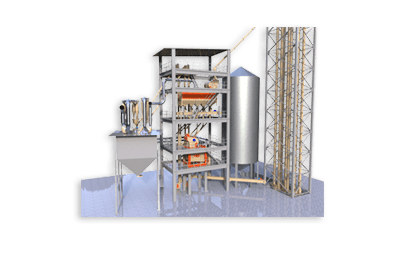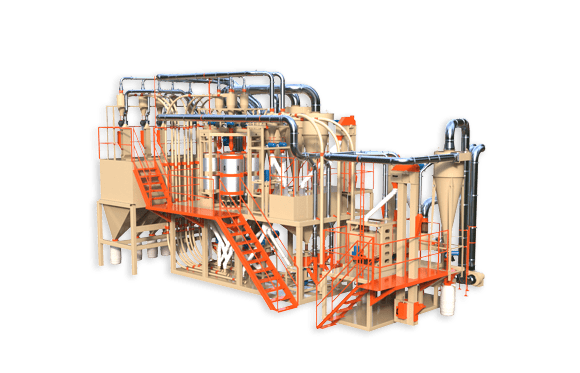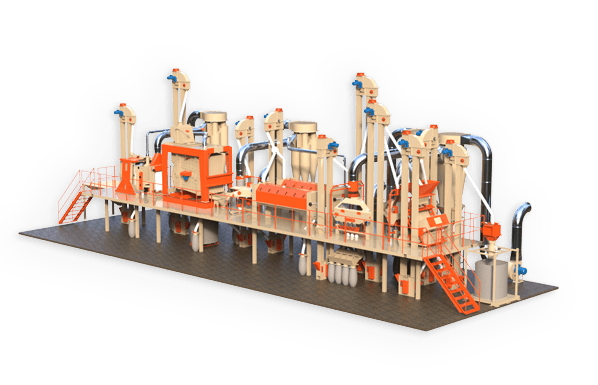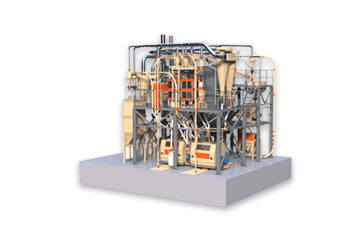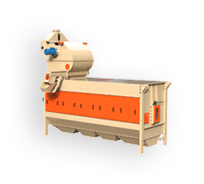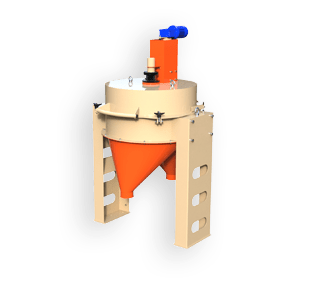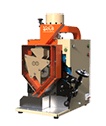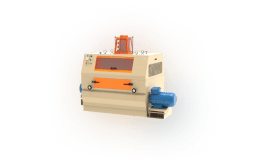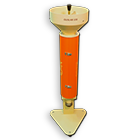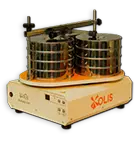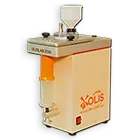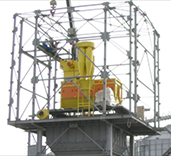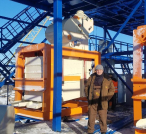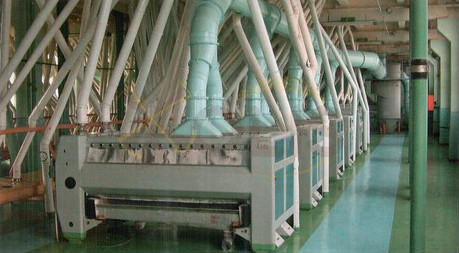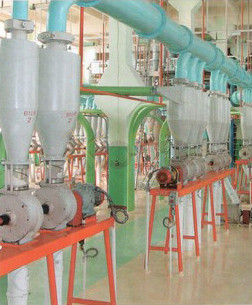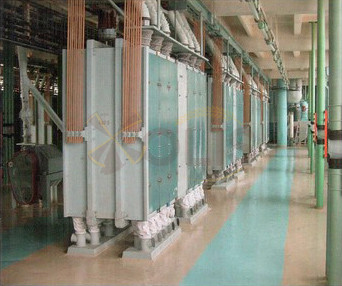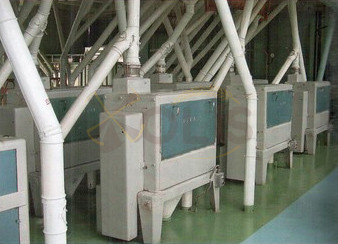A.P. Vereshchinsky, Ph.D. tech. Sciences, General Director of LLC “OLIS” (Odessa)
Some agro-industrial enterprises and holdings, having succeeded in grain production, are seeking to create or expand its processing. Often, mill production for the production of high-quality wheat flour comes into their field of vision. Our observations show that most managers mastering this new type of business are prone to mistakes in choosing effective means of its implementation. Flour-grinding production is characterized by deep specifics that go far beyond the stories of sales managers of a particular equipment manufacturer. In this article we will still try, without much introduction into technological aspects, to clarify at least the basic organizational and technical approaches to creating a successful mill production
IMPORTED OR DOMESTIC?
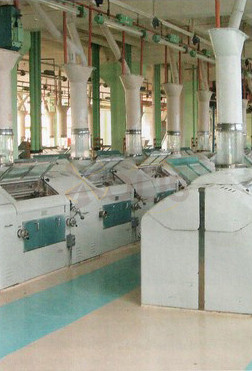
Thus, the huge payback period for most newly created industries is a mandatory, but not the only payment their owners must pay for technical ignorance, as well as excessive trust in sellers of “advanced technologies” and “know-how” HOW.”
As a rule, the initial perception of a mill by most potential investors is concentrated on the production building. Sure, it’s an important part, but it’s only part of production. Any flour mill, even the smallest capacity, in addition to the production building (the mill itself), must include a warehouse for raw materials, a workshop (warehouse) for finished products, a system of laboratory, operational control and management of the production process, a system for accounting and registration of operations with grain. In terms of their creation costs, the listed components are comparable to the costs of a production building. However, without any of them, successful production is impossible.
HOW TO CONTROL THE QUALITY OF FLOUR?
It is known that to ensure successful sales, the quality of manufactured products must meet regulatory requirements and be stable. In relation to flour, this condition can be met by processing grain with certain stable properties. However, his incoming batches are always distinguished by significant diversity. Obtaining a batch of grain with specified characteristics (grinding batch) is achieved by mixing two or three initial batches (components) in the required proportions. A change in the quantity or quality of components in a grinding batch requires a change in processing modes, which is always associated with losses in the quality and yield of flour.In this regard, the grinding batch must be prepared for a long period of work, which requires a supply of initial batches of grain. Thus, the raw material warehouse must ensure acceptance, separate placement, storage and supply of initial batches of grain to production. Its capacity should allow uninterrupted supply of production with stable components of the grinding batch for at least 10 days of operation. Taking into account the need for separate storage of different batches, in addition to the total capacity, an important aspect is the availability of separate containers by quantity. The warehouse can be either a floor type or a silo (elevator). However, when choosing the type of modern silos made of light steel structures, preference should be given to silos with conical bottoms. Such silos are completely emptied upon unloading, which does not require manual cleaning after storage of each batch. Grain supplied for processing must not exceed the established contamination indicators. Violation of such standards inevitably entails a sharp decrease in the quality of the produced flour. Therefore, it is advisable to equip a raw material warehouse with cleaning means. Preference should be given to elevator separators, because mill separators are inefficient for operation in grain receiving mode.
TECHNOLOGICAL PROCESS OF GRINDING
In the production building (the mill itself), grain is prepared for grinding and ground to obtain finished products – flour and bran. The main stages of preparation include the preparation of a grinding batch, grain cleaning and conditioning (humidification to a certain humidity followed by storage in bunkers). In the grinding department, the basis is the operations of multiple sequential-parallel grinding and sifting. Modern trends in the creation of mill production are aimed at grinding grain according to a reduced structure. This requires fewer pieces of equipment, less space, less electricity, etc., which significantly reduces the costs of creation and operation. However, the exclusion of a number of technological operations and an increase in loads on equipment negatively affects the processing results. Nevertheless, the effective conduct of such grinding has been proven by practice, although it requires special, especially careful preparation of the grain. On the other hand, it is in the preparation of grain that there are huge reserves for increasing processing efficiency for any grinding structure. Therefore, when choosing or creating a mill production, maximum attention should be paid to the equipment of grain preparation equipment.
The grinding process is characterized by a hierarchical structure. However, the need for serial-parallel processing results in a complex system of continuous movement of multiple flows, differing both in productivity and in the quality of the products being moved. The movement of product flows along given routes, as well as the ability to quickly change their direction, is ensured by the communication of mechanical, pneumatic and gravity transport. The most economical and technically feasible option is vertically oriented communication, in which the product rises upward and is processed, flowing from machine to machine by gravity. The minimum number of “lifts”, as well as all transport devices, with maximum “maneuverability” of routes, is ensured by the arrangement of the mill in several levels (floors). The layout of the mill “in height” also creates favorable conditions for the effective solution of a number of technical and technological problems, which ultimately results in a significant increase in the quality and yield of flour. Practice shows that production capacity is up to 100 t/day. should be built in four, and over 100 tons/day – in five or more floors. However, many mill productions are being created “in breadth”. The implementation of such solutions is often caused by the desire of customers to “stuff” flour production into an adapted warehouse or hangar. In a number of cases, developers unreasonably sacrifice the number of storeys in order to save load-bearing metal structures. For the implementation of such solutions, the owners of such mills are forced to pay with their low efficiency.
Choosing a mill for flour production
Mill suppliers often provide equipment payback calculations. Such calculations show a payback period, usually from 4 to 9 months, which are purely indicative, since they cannot take into account the local operating conditions of the mill.
To compare different types of mills, you can use a formula that contains the main criteria for assessing the grinding result (flour yield and its quality indicator – ash content):
Kt = I x (Z0 – Z1</sub >) / Z0,
where Kt is the technological efficiency coefficient;
I – flour yield, %;
Z0 – ash content of grain entering the grinding, %;
Z1 – ash content of flour, %.
Example:
If the ash content of wheat is 1.85%, the ash content of endosperm is 0.42%, the endosperm content is 80%, then
Kt = 80% x (1.85% – 0.42%) / 1.85% = 61.84
Some of the manufacturers of milling plants overestimate the yield of high-grade (low-ash) flour or indicate the values achieved when processing wheat, the quality of which is significantly above average.
It is important to determine the actual yield of flour and bran during grinding.It is this indicator that determines the efficiency of grinding and, ultimately, the profitability of the mill, which is of great interest to the owner. When choosing a mill, you should not be guided only by its passport data; it is necessary to have the results of its tests in the process of experimental grinding on site.
According to Promline LLC, Russia
STORAGE OF THE FINISHED PRODUCT – FLOUR
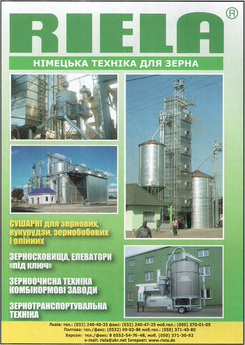
A PERSON MUST MANAGE THE PROCESS
The dependence of grinding results on a huge number of heterogeneous factors does not allow us to completely entrust the control of flour production processes to even the most modern and sophisticated machines. Flour milling technology is one of the most complex in the food and processing industry, and the qualifications of a technologist, known in the old fashioned way as a grain miller, are more of a craft than a specialty. Thanks to the constant and qualified intervention of the grain miller in the grinding processes, technological conditions at each stage of processing are ensured that are close to optimal, and as a result, the best final results. To objectively assess the situation, the grain grower needs to have qualitative and quantitative indicators of production performance, which is ensured by the organization and systematic implementation of laboratory and operational control. Laboratory control is carried out by the production and technical laboratory (PTL). Operational control is carried out at workplaces by production personnel, ensuring established modes of operations and their effectiveness.
For each shift of production personnel, it is mandatory to record the work done with the preparation of primary reporting documentation. The results of work are determined at the end of each shift and are documented in accordance with the form accepted by the enterprise. However, they must necessarily contain complete and reliable information about the quantity and quality of grain transferred (accepted) for processing, production (transfer to warehouse) of finished products, consumption of containers, waste disposal, etc. The safety of material assets at all stages of movement during the production process is ensured only by their responsible transfer in terms of quality (using laboratory control) and quantity (using weighing equipment). Determining the exact performance indicators for a month or ten days is carried out by completely threshing out all grain received during the reporting month, emptying all bins and stopping production, i.e. cleaning is carried out.
Average economic performance of mills with a capacity of 30-100 tons/day. as of January 2009
The cost of processing one ton of grain is 1265 UAH, of which:
- average cost of a ton of grain in a grinding batch is 1050 UAH;
- cost of electricity consumption – 50 UAH;
- the cost of a bag is 40 UAH;
- wages costs – 75 UAH;
- unaccounted expenses – 50 UAH.
Proceeds from the sale of finished products obtained from processing one ton of grain – 1512 UAH, namely:
- 570 kg of premium flour at a price of 21 UAH/kg for the amount of 1197 UAH;
- 150 kg of first grade flour at a price of 1.6 UAH/kg for the amount of 240 UAH;
- 250 kg of bran at a price of 0.3 UAH/kg for the amount of 75 UAH;
- 30 kg – waste that cannot be sold and losses.
Enterprise income from processing one ton of grain: 1512 – 1265 = 247 UAH.
The amount of costs required to create a mill production ranges from 60-80 thousand UAH. per ton of daily mill output. It is easy to calculate that the costs of creating a mill business from scratch approximately correspond to its annual income. Thus, with the right approaches to creating a mill production, the payback period for investments should not exceed one year.
Based on materials from OLIS LLC
FLOUR GRINDING ECONOMY
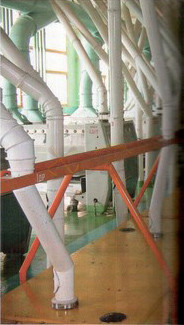
In conclusion, it should be noted that flour mills are complex engineering structures and must be created according to pre-developed designs. The level of technical problems solved in the process of creating production is much higher than the level of competence of even the most highly qualified “operators”. Such work can be done by groups of specialists who have a deep knowledge of the necessary complex of knowledge, where flour production technologies occupy a central place.
COMMENTS
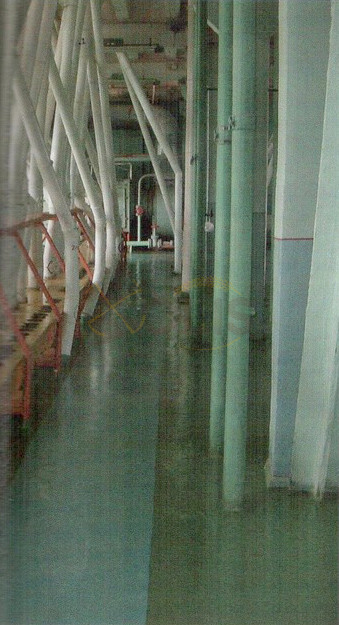
Today, a number of factors frankly do not contribute to the development of the flour milling business. Firstly, there is an excess of grain grinding capacity. Secondly, constant government intervention in the development of the flour-milling industry, in particular the introduction of restrictions on the profitability of flour millers and bakers. Flour interventions from the State Reserve significantly reduce flour prices, which makes flour production even less profitable. The state is always worried that, God forbid, bread prices do not rise. Meanwhile, we, flour millers, are selling our production capacity. For example, I have already sold two mills and kept one for myself, the last mill and elevator.
Under conditions of very low grain quality, it is extremely difficult to produce high-quality flour that could meet European or, say, Israeli standards. As a result, in fact, the only sales market is the domestic market. Although it is in principle possible to export flour abroad.
If someone, in the current conditions, still dares to create a business for the production of flour, such a daredevil must secure in advance a sales market for at least 50% of the products produced . And now, to find markets, you need to make a remarkable effort. And, by the way, you also need to remember: the deferred payment for purchased flour will last from 7 to 60 days. So a potential flour miller must be ready to work for two months on sheer enthusiasm.
Anatoly Yakhvak, director of SPD “Yakhvak”, Odessa region
Today there is great competition in the flour market, especially in the Odessa region. Therefore, if a person really wants to start a flour milling business, he cannot do without a well-prepared team, significant start-up capital, and an understanding of what, in fact, he wants to get from the mill. After all, grinding flour is a difficult task, with many nuances that cannot be explained in ten minutes. This requires, rather, a whole lecture.
The market for its products is very important for a flour mill.The domestic market is saturated with offers of different types of flour, but if you achieve good quality indicators of flour, you will always be able to sell your product. By the way, in some European countries the quality of flour is even worse than what Ukrainian farms produce now.
For grinding it is better to use domestic equipment. Although domestically produced mills may in some ways be inferior to their foreign counterparts, in terms of price/quality ratio, as well as in terms of further service capabilities, our mill equipment is better than imported ones.
Published based on materials from “GRAIN” No. 03 (35) 2009
All-Ukrainian Journal of Modern Agroindustrialist


